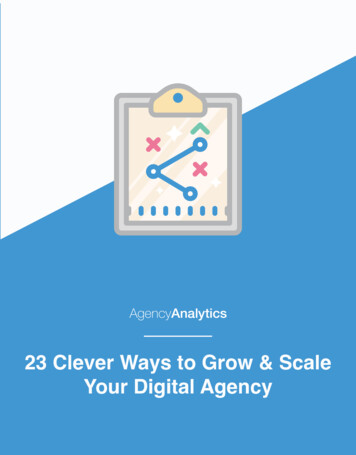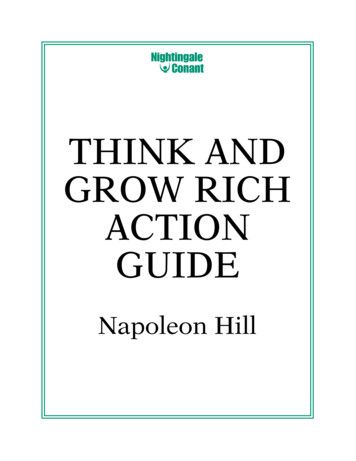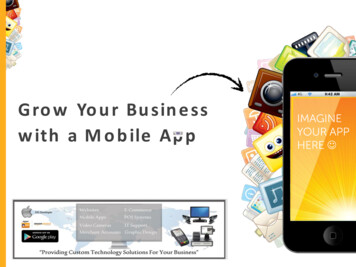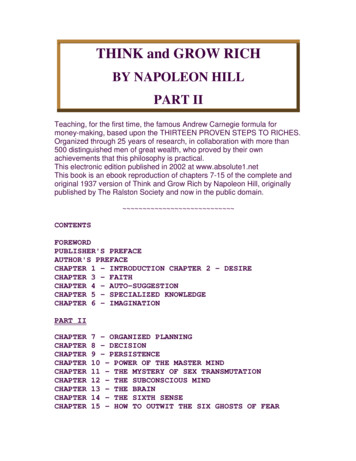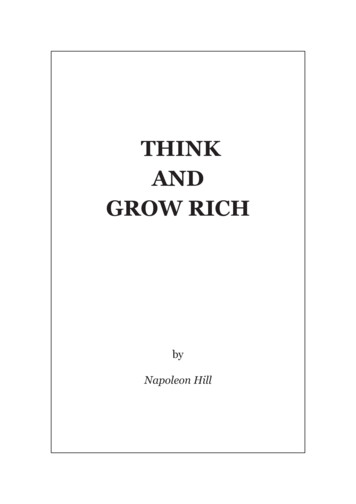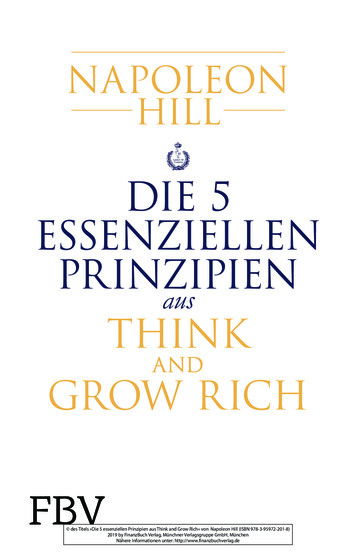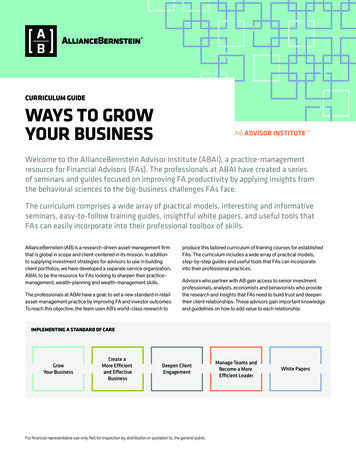
Transcription
CURRICULUM GUIDEWAYS TO GROWYOUR BUSINESSAB ADVISOR INSTITUTE SMWelcome to the AllianceBernstein Advisor Institute (ABAI), a practice-managementresource for Financial Advisors (FAs). The professionals at ABAI have created a seriesof seminars and guides focused on improving FA productivity by applying insights fromthe behavioral sciences to the big-business challenges FAs face.The curriculum comprises a wide array of practical models, interesting and informativeseminars, easy-to-follow training guides, insightful white papers, and useful tools thatFAs can easily incorporate into their professional toolbox of skills.AllianceBernstein (AB) is a research-driven asset-management firmthat is global in scope and client-centered in its mission. In additionto supplying investment strategies for advisors to use in buildingclient portfolios, we have developed a separate service organization,ABAI, to be the resource for FAs looking to sharpen their practicemanagement, wealth-planning and wealth-management skills.The professionals at ABAI have a goal: to set a new standard in retailasset-management practice by improving FA and investor outcomes.To reach this objective, the team uses AB’s world-class research toproduce this tailored curriculum of training courses for establishedFAs. The curriculum includes a wide array of practical models,step-by-step guides and useful tools that FAs can incorporateinto their professional practices.Advisors who partner with AB gain access to senior investmentprofessionals, analysts, economists and behaviorists who providethe research and insights that FAs need to build trust and deepentheir client relationships. These advisors gain important knowledgeand guidelines on how to add value to each relationship.IMPLEMENTING A STANDARD OF CAREGrowYour BusinessCreate aMore Efficientand EffectiveBusinessDeepen ClientEngagementFor financial representative use only. Not for inspection by, distribution or quotation to, the general public.Manage Teams andBecome a MoreEfficient LeaderWhite Papers
TABLE OF CONTENTSABAI’s seminars and guides are broken down into four categories all centered aroundthe concept of creating a higher Standard of Care. The Standard of Care can be used toimprove a wide array of areas within your practice—from generating new referrals andserving clients more effectively to improving the productivity of your team. Find thesection that corresponds with your interest, or browse through the curriculum to seewhat is right for your needs.INTRODUCTIONTeam Biographies1GROW YOUR BUSINESS These programs provide strategies for using a Standard of Care to take your business to the next level.The Professional Referral Method: Becoming the Trusted Advisor2The Effective Case Study: Selling Your Superior Problem-Solving Value2Inspiring Referrals from Clients, Acquaintances and Social Media3Target Marketing: Developing Your Unique Value Proposition3Referral Strategies for Bank Advisors4Growth Through Acquisition4CREATE A MORE EFFICIENT AND EFFECTIVE BUSINESSEffective asset management is no longer enough. These programs teach you how to use a Standard of Care to be more successful atmanaging your business.Key Steps for Navigating the Transition to Advisory5A Higher Standard of Care5A Higher Standard of Care 2.0: Managing Client Satisfaction in the Age of Skepticism6The Pricing Conversation6Growing Resilience: Unleashing Human Potential6Managing People Who Hate Being Managed7Building a Highly Resilient Practice in a Deeply Disrupted Industry: Another “Kodak Moment”?7Advisor’s Guide to Using Language Artfully8Managing Disruption and Doubt by Inspiring Trust and Communicating Value8Using Checklists to Manage the Crisis of Skepticism9DEEPEN CLIENT ENGAGEMENT As must understand why clients do what they do. These resources show you how to use your Standard of Care to enhance the connectionFwith your clients.The Late-Stage Advisor: Preparing Clients for What Happens Next10Words That Change Minds: Steps for Managing Client Behavior10Managing the Hard Conversation: Working with Emotional Clients10How to Get Clients to Take Action Now11Practical Guide to Behavioral Finance11For financial representative use only. Not for inspection by, distribution or quotation to, the general public.
Effective Client Review: The Foundation for a More Productive Practice12How to Present Your Capital Markets Perspective12The Art of Deep Discovery13The Art of the Effective Close13How to Explain What You Do: A Holistic Wealth Advisor14How to Introduce a New Idea to an Existing Client14How to Overcome Resistance15Investing for Impact15MANAGE TEAMS AND BECOME A MORE EFFICIENT LEADER any FAs work as part of a team. Strong leadership skills are important. Building the right team and working effectively together can beMchallenging. These resources can help ensure a Standard of Care when working with your team.Setting the Stage for a Smart Sale: Framework for Acquiring a Practice16Five Mistakes That Teams Make and How to Avoid Them16Power Tools for Hiring: How to Build a High-Performance Team17Succession Planning: Steps from Exit Fantasy to Exit Strategy17Why There Is No Such Thing as Time Management18Defining Roles and Setting Goals for a More Productive Team18Healthy Team Checklist18WHITE PAPERSBased on the research and insights of behavioral sciences, these papers present the task of the FA from a different perspective and providestrategies for building a successful financial advisory business.Four Great Reasons to Hire a Muni Pro19How to Talk About Performance19Pay Me Now, or Pay Me Later20Prioritizing Discipline: Setting Priorities with Clients20How to Introduce Active Management21Better than Buffett: Using Behavioral Finance to Improve Decision-Making21How to Get Stuck Prospects Moving22Inside the Mind of the Uniquely Successful Investor22Comprehensive Wealth-Management, Age-Related and Situational Checklists23The 10,000-Year Solution24Using Science to Become a Much Better Investor24Dollar Cost Averaging25Why So Many Advisory Teams Fight About Urgency25Creating “Wow” in 5 Minutes (or Less!)26Guidance on Managing Seminars26Right-Sizing Your Business27The Science of the Effective Voice Mail27The Science of the Effective Email27For financial representative use only. Not for inspection by, distribution or quotation to, the general public.
INTRODUCTIONKen Haman joined AB in 2005 from a private consulting practice to the financial-servicesindustry. In his current position, he develops and delivers consulting and training to FAs andkey leaders at AB’s partner firms, specifically in the areas of strategic marketing, effectivecommunication with clients, and practice-management strategies for advisors, advisoryteams and managers.Ken HamanManaging DirectorMr. Haman’s professional experience includes managing a practice in psychotherapy for20 years in the Washington, DC, area and a consulting practice to large organizations,financial professionals and senior executives in the mid-Atlantic states. He holds a BA inbusiness administration, graduate degrees in psychology and theology, and certificationsin clinical hypnosis and neuro-linguistic programming.Scott Tatum delivers consulting and training to FAs and key leaders at AB’s partner firms,specifically in the areas of effective communication with clients and practice management.Mr. Tatum came to AB in 2008 from MFS Investment Management, where he was a regionalvice president. His 30-year career in financial planning includes two other important positions:he spent eight years in the Dallas area with OppenheimerFunds; earlier, he spent sevenyears as national sales manager for a financial planning firm based in Irving, Texas, wherehe coordinated marketing programs for a field force of more than 4,000 FAs.Scott M. Tatum, CIMA, CFPDirectorIn addition to being a Certified Financial Planner and Certified Investment ManagementAnalyst, Mr. Tatum holds NASD Series 7, 24, 53 and 63 licenses. He is an honors graduateof the University of North Texas.IMPLEMENTING A STANDARD OF CARE CAN IMPROVEA WIDE ARRAY OF AREAS WITHIN YOUR PRACTICE:GENERATING REFERRALS, SERVICING CLIENTS ANDIMPROVING PRODUCTIVITY.1For financial representative use only. Not for inspection by, distribution or quotation to, the general public.
GROW YOUR BUSINESSTHE PROFESSIONAL REFERRAL METHOD:BECOMING THE TRUSTED ADVISORTHE EFFECTIVE CASE STUDY:SELLING YOUR SUPERIOR PROBLEM-SOLVING VALUEMATERIALS: PRESENTATION AND EXECUTION GUIDEIn today’s challenging environment, Financial Advisors are increasinglymarketing not only to clients, but also to professional intermediarieswho serve as gatekeepers to wealthy families. To accommodate thisshift, FAs must change their message from one that is valuable to onethat is referable.MATERIALS: PRESENTATION AND EXECUTION GUIDEMuch of what a Financial Advisor does is complicated and difficultto understand—even for other professionals. Experience has shownthat unless CPAs and attorneys clearly understand the value that FAscan deliver, they are often reluctant to refer their clients to any advisor.Therefore, advisors must provide clear and compelling examples ofthe value their services provide.This program offers four specific strategies for executing a messagingprocess to this new market. It provides instructions for creatingwarm introductions to professionals, then teaches how to developa referable message, structure a presentation for an intermediaryand close a meeting for an action.SPECIFIC TOPICS COVERED INCLUDE: The difference between a valuable message and areferable message A four-step process for managing outreach to gatekeepers How to create a referable message Scripts and guidance for scheduling and managing meetingsWhen the FA can present a case study that shows an example ofsolving a particular wealth-management or wealth-transferenceproblem, a CPA or attorney is better able to understand the clientexperience that the FA delivers. To help FAs more effectivelycommunicate this message and create a case study, this 60-minutepresentation explores key aspects of communicating their value toother financial professionals.SPECIFIC TOPICS COVERED INCLUDE: How to target “high-opportunity” problems related to wealth How to use financial planning software as a problemsolving resource How to construct a case study document that clearly illustratesthe magnitude and complexity of a wealth-related problem andhow to deliver the most effective long-term solution Specific language patterns to use and information to include inthe case study to increase its effectiveness How to use the document in a meeting with a potential centerof influenceFor financial representative use only. Not for inspection by, distribution or quotation to, the general public.WAYS TO GROW YOUR BUSINESS2
INSPIRING REFERRALS FROM CLIENTS,ACQUAINTANCES AND SOCIAL MEDIATARGET MARKETING:DEVELOPING YOUR UNIQUE VALUE PROPOSITIONMATERIALS: PRESENTATION AND EXECUTION GUIDEAs Bill Good pointed out, “Quit asking for referrals. you have topromote, not solicit, referrals.” As any seasoned Financial Advisorhas experienced, asking for referrals generates a few names anda lot of annoyance—annoyance that an FA can’t afford.MATERIALS: PRESENTATION AND EXECUTION GUIDETo succeed in today’s highly competitive marketplace, FinancialAdvisors must appeal to increasingly sophisticated investors witha differentiated business. How? Define a target market and developa compelling unique value proposition (UVP).Experienced FAs know the difficulties of transforming a friend orsocial contact into a meaningful client—despite the fact that a largepercentage of investors are either somewhat or extremely dissatisfiedwith their advisor. This shouldn’t stop FAs from requesting referralsfrom existing clients or social acquaintances. The key is to educatethe referral source and ask for the referral in the proper way.This 60-minute presentation introduces FAs to the challengesof prospecting in the “very small pond” of wealthy investors: whatthey demand in an FA and when and how to connect with them. Adetailed model shows how to develop and deliver an effective UVPthat will differentiate your business and help you achieve success.The material is highly practical and fast-paced and comes with astep-by-step guide to assist participants in developing their owncustomized UVP.To teach advisors the best way to request a referral, this 60-minutepresentation explores key aspects of becoming a trusted advisor.Participants are given valuable tips for creating an outreach contactlist, selecting the right capabilities to feature in a practice capabilitiesbrochure and designing a preliminary storyline for the messaging.SPECIFIC TOPICS COVERED INCLUDE: The psychology behind when and why friends and currentclients will and won’t make personal referrals How to create a referral-generating messageSPECIFIC TOPICS COVERED INCLUDE: An overview of the changing financial-services marketplace An explanation of what a UVP is and why it is important Three approaches to defining your target market Seven steps to developing your UVP Six simple exercises to help you construct an ideal UVP How to design and illustrate a practice capabilities brochurefor use in meetings with clients and social acquaintances Steps to making an “annoyance-free” contact with any clientor acquaintance that will increase the likelihood of a referral3For financial representative use only. Not for inspection by, distribution or quotation to, the general public.
REFERRAL STRATEGIES FOR BANK ADVISORSGROWTH THROUGH ACQUISITIONMATERIALS: PRESENTATION AND EXECUTION GUIDEOver the past 30 years, important changes have occurred in thecultural landscape of North America that have impacted the waybank-based Financial Advisors can build a pipeline of referralsfrom banking colleagues.MATERIALS: PRESENTATION AND EXECUTION GUIDEIn 2018, Cerulli Associates estimated that there were 70,000 clientfacing Financial Advisors
resource for Financial Advisors (FAs). The professionals at ABAI have created a series of seminars and guides focused on improving FA productivity by applying insights from the behavioral sciences to the big-business challenges FAs face. The curriculum comprises a wide array of practical models, interesting and informative seminars, easy-to-follow training guides, insightful white papers, and .

